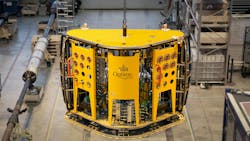Wireless intervention, completion systems eliminate topside power, pump requirements
By Jeremy Beckman, London Editor
Gas and oil production offshore Norway has rebounded to levels not seen for 15 years, according to the Norwegian Offshore Directorate. Its recent review of the sector credited high regularity on producing fields as one of the factors and noted the impetus for fast-track tiebacks of last year’s infrastructure-led discoveries, however small.
Optime Subsea is supporting this activity by introducing patented upgrades to its subsea well control and completion systems, SCILS and ROCS, which have undergone deployments on multiple fields offshore Norway operated by Aker BP and Harbour Energy over the past five years.
The company, formed in Notodden, Norway, by four individuals previously employed by FMC Technologies, initially developed the SCILS (Subsea Controls & Intervention Light System). This operated successfully on a subsea P&A campaign for Aker BP on the Jette field in the North Sea during its first commercial run-out on 2019. It was designed to simplify well access, interventions and workovers from any type of vessel by transferring hydraulic controls and power to the seafloor, dispensing with the heavy equipment or topside container typically associated with conventional Installation Workover Control Systems (IWOCS).
In its early commercial format, the SCILS occupied a footprint on the seabed of 3.7 x 2.5 x 3 m, including control modules and 3-kW internal pumps operating typically at 3 l/min in low pressure mode (345 bar) and 1 l/min at high pressure (690 bar). A 36-mm diameter tether from the surface supplied power and communication. The system’s second deployment was on an Aker BP-operated field in the North Sea, and Optime now operates the SCILS routinely on the Norwegian major’s subsea wells via a frame agreement.
Case studies
According to Ole-Ivar Sørensen, technical manager for eSCILS, there have been 22 operations for Aker BP to date comprising 12 with the SCILS and 10 with eSCILS, the latest generation SCILS for completion, xmas tree testing and P&A. This wireless version of the technology can operate entirely without power from the topside; instead, it is powered by batteries integrated into the subsea equipment spread.
“So these are two versions of same tool," Sørensen said. "We have also conducted multiple operations for Harbour Energy in Norway [via another frame agreement with what was formerly Wintershall Dea Norge]. The SCILS and eSCILS have been used on subsea trees delivered by Baker Hughes, TechnipFMC and OneSubsea, with all operations performed successfully without any recorded NPT [non-productive time]. There are both SCILS and eSCILS operating from the semisubmersible rigs Deepsea Nordkapp and Scarabeo 8 for Aker BP and from Transocean Norge for Harbour Energy. Our team has also operated an eSCILS from the DeepOcean IMR vessel Edda Freya, installing a xmas tree in the Norwegian Sea for Harbour Energy.
“Feedback from clients and rig teams to date is that they are satisfied with the integration of the SCILS/eSCILS into the rigs’ various onboard systems. Optime service personnel are now able to mobilize the full equipment spread and make it fully operable, including conducting the test, within two days.
For applications involving the eSCILS, the composition of the seabed battery package depends for each operation on the water temperature, number of hydraulic lines, communications and other factors that impact power consumption, Sørensen explained.
“But for a typical operation on the Norwegian Continental Shelf," he added, "we have placed the eSCILS on the seabed two months prior to operation, installed the system and tested the xmas tree, and performed the well completion test—including seal test and tubing hanger plugs—and still had good margins of power."
He continued, “The battery composition is calculated to be sufficient for performing a full XT installation, including all handover and seal tests, and also completion tests with the ROCS and XT including tubing hanger plugs. All the batteries are fully redundant with calculations featuring margins of around 25%; that has proven to be sufficient for a full installation and completion job. There is also an onboard charger to trickle charge to the batteries if needed from either an ROV or from a backup reeler. The system (batteries) can be set into 'sleep mode' when not in use and then awakened from ROV when needed. There is also a 'kill' switch [an ROV-operated subsea switch to turn power off], and an inverter system for XT AC power to the subsea control module [SCM], providing 230, 400 or 550 V AC."
In addition, the eSCILS works with Optime’s compatible subsea hydraulic pumps.
“These are positive displacement pumps with super durable ceramic pistons," Sørensen said. "That enables us to deliver pumps with a volumetric efficiency of 92-96%, because the seals stay tight at all speeds and pressures. We can produce up to 12,500 psi [862 bar] with the pumps, and in three configurations—with one, two or five pistons.”
The eSCILS is also compatible to control the ROCS through the wireless BOP antenna, meaning all Optime interfaces can be run through and controlled by the eSCILS.
Aker BP expects to keep growing its inventory of subsea production wells over the next few years. According to Sørensen, the step-out distance will have no impact on the eSCILS and any associated tasks it might be called on to support in future.
“Since the eSCILS is powered from batteries locally, there is no need for long umbilicals with the associated risk of loss of power," he said. "In fact, the system should be a perfect fit for any longer-distance and deepwater marginal fields due to not being dependent on umbilicals. Now we are starting to experience strong interest in the eSCILS from operators in other key oil and gas hubs worldwide.”
Compact subsea control system
Optime developed its Remotely Operated Controls System (ROCS) to remove the need both for the topside IWOCS and the umbilical for operation of tubing hanger running tools to install tubing hangers. The system was engineered to connect to the drillpipe just above the THRT with the control system located in the landing string. Initial deployments in the early 2020s involved installing and retrieving the tubing hangers of Aker Solutions and Baker Hughes vertical trees on various Aker BP fields. The system weighed about 5 metric tons, occupied a 5- to 10-sq m footprint, and it was taking about three days to install and operate.
Optime has now developed a new version, eROCS, with the first factory acceptance test imminent.
“This will by far be the most advanced and compact subsea control system on the market,” Sørensen claimed. “The main enabling technology being our new V3 digital hydraulic control valve. The eROCS eliminates the need for dual pumps (LP and HP), with built-in pressure monitoring and a pressure/flow regulator with a high level of accuracy. It will be only around one-third of the length of the earlier generation ROCS; in most cases, it will fit below the shear ram.”
The system is tested for 10,000 psi (690 bar) external pressure, with constant communication, for deployment inside the high-pressure area in a BOP. The same eROCS main module is used in both a simplified mode, for dead wells, and SSTT (Subsea Test Tree) wireline mode for live wells. It is possible to swap between modes offshore.
“We believe it represents the pinnacle in subsea intervention, completion and workover control, eliminating the need for large topside spread such as umbilicals and HPUs. It also optimizes operational safety, deckspace and crew size for offshore completion and intervention tasks," Sørensen said. “Communication is facilitated by Optime’s field-proven wireless system, which transmits through well fluids to a pre-installed node in the BOP, with surface connection enabled via an ROV, ROV-cage, downline, BOP control box or eSCILS. It can also provide enhanced digital capabilities via a custom HMI [human machine interface], rendering conventional surface controls obsolete.”
In parallel, Optime has developed the OTHOS (Optime Tubing Hanger Orientation System) and Smart DWIGS (Dead Well Intervention Guide System) for tubing hanger orientation for vertical VXT applications, and wireline runs in open marine riser. The complete system, in all configurations, communicates through the company’s wireless system.
Sørensen concluded, "The OTHOS replaces traditional BOP alignment systems, and offers extreme accuracy and significant cost savings. Smart DWIGS, we believe, is the most advanced intervention guide system for running plugs in open marine risers. It provides full control of all tubing hanger running tool, tubing hanger and downhole functions while in umbilical-less wireline mode…and eliminates the need to run force-open sleeves for downhole safety valves.”
About the Author
Jeremy Beckman
Editor, Europe
Jeremy Beckman has been Editor Europe, Offshore since 1992. Prior to joining Offshore he was a freelance journalist for eight years, working for a variety of electronics, computing and scientific journals in the UK. He regularly writes news columns on trends and events both in the NW Europe offshore region and globally. He also writes features on developments and technology in exploration and production.


